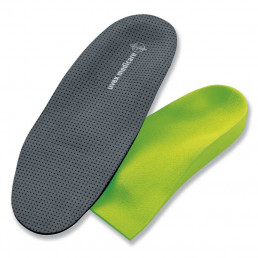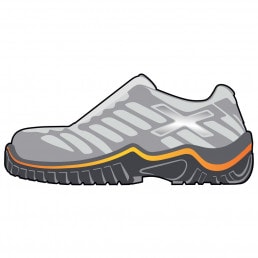Does your shoe fit perfectly? Very few people can answer this question with a true “yes”. A shoe that fits perfectly is important for your health: particularly when performing work that is mainly carried out while walking or standing, poor-fitting work shoes can lead to severe pain and permanent damage to your health. When it comes to your feet, solutions for pain-free, healthy working include individually tailored safety footwear and orthopaedic insoles. In this blog article, we clarify who bears the costs for your custom insoles.
Who covers the costs of insoles for safety footwear?
At work, there are two ways to ensure that your feet remain comfortable, and that your health consequently remains unaffected:
- Individually tailored safety footwear (PPE)
- Individually required orthopaedic accessories
For many workers, an individually tailored safety shoe alone is sufficient to remain comfortable and pain-free when carrying out their tasks. In this case, the employer is responsible for equipping employees with professional safety footwear that is adapted to their individual requirements. These must comply with general ergonomic requirements as well as health and safety requirements specific to the corresponding activity.
According to statutory accident prevention regulations, the employer is therefore solely responsible for covering the costs of individually tailored safety footwear (personal protective equipment), should this be deemed necessary for the field of work following an in-depth examination.
However, if an employee requires individually tailored safety footwear that goes beyond the standard ergonomic requirements, orthopaedic insoles or orthopaedic safety footwear must be individually manufactured for this employee. The first point of contact for orthopaedic foot protection is the relevant specialist medical professional, who will investigate whether such orthopaedic foot protection is genuinely required. If this proves to be the case, an employee should then seek advice from a medical equipment supplier and request a cost estimate for the custom orthopaedic insoles required. The costs of orthopaedic insoles and orthopaedic safety footwear can also be covered by the employer, although the employer is under no obligation to do this.
If the employer cannot or does not want to cover the costs for such orthopaedic equipment, these may well be able to be borne by another party instead, including social insurance agencies, the Berufsgenossenschaft or the Deutsche Rentenversicherung. In an individual employee’s case, it will be examined in detail in advance whether these institutions are able to cover the costs.
Insoles for safety footwear: What do the pension authorities pay?
If you require orthopaedic safety footwear or insoles due to an accident at work, the relevant employer’s liability insurance association usually assumes the costs. Otherwise, an “Application for benefits for participation in working life (vocational rehabilitation)” can be submitted to a social insurance agency.
However, please take note of which specific costs the social insurance agency actually pays. Below is a short list of the costs covered by the Deutsche Rentenversicherung:
- Insoles in safety footwear, protective footwear or professional footwear
- Orthopaedic foot protection:
- Adjustment of a safety shoe, protective shoe or professional shoe
- Procurement of custom-made orthopaedic safety footwear, protective footwear or professional footwear
- Procurement of modular footwear that is required due to a disability
- Repair of the orthopaedic portion of the safety footwear, protective footwear or professional footwear à only if proof of the need for repair by an orthopaedic shoe maker exists
Once the types of foot protection covered by the German pension authorities in terms of cost have been clarified, it is necessary to find out how much funding will be provided according to the regulations and the cost estimate.
If you have met all personal and insurance requirements, the costs for insoles in safety footwear, protective footwear or professional footwear will be covered in their entirety. If your employer does not have an obligation to cover the costs, the costs will be borne in full by the social insurance agency. This means that, in cases where orthopaedic work shoes need to be adjusted or repaired, the only costs covered relate to the orthopaedic part of the shoe. As every employer is obliged to provide employees with personal protective equipment, the employer bears the costs for the production of the type-tested safety footwear and the social insurance agency only covers the costs for the orthopaedic insoles or adjustments.
The employer always deducts the compulsory contribution for ergonomic work shoes from the total costs — the employer’s own contribution amounts to EUR 40 per shoe. This does not apply to insoles and adjustments.
It should be noted that the costs can only be covered in advance of the purchase of the orthopaedic foot protection. This funding cannot be applied for after footwear has been purchased!

Application to cover the costs of insoles for safety footwear
You must meet certain requirements to apply for coverage of costs relating to the purchase of safety footwear:
- Your ability to work must be significantly impaired or at risk due to a physical disability
- By means of rehabilitation measures, the impairment to your ability to work will be averted or improved
- The onset of your occupational disability can be averted
- When submitting an application (the application documents can be downloaded using the button below):
- You have fulfilled the waiting period of 15 years or
- You already receive a pension because of reduced ability to work or
- You have received mandatory contributions for insured employment for six months in the last two years or
- You have performed an insured activity within two years of the end of a training course in the period leading up to the application, or were unemployed/unable to work after such employment or
- You are already less capable of working or expect to be in the foreseeable future, and have fulfilled the general waiting period of five years.
If you meet the above criteria, you can obtain the application documents from the Deutsche Rentenversicherung, your health insurance provider, the relevant Agentur für Arbeit or the rehabilitation service centre. Alternatively, you can download the application directly via the following button.
Checklist for application documents
- Application for benefits for participation in working life (G0100)
- Information on professional development (G0130)
- Information on the coverage of costs for auxiliary equipment and technical work aids that are required to perform a profession on grounds of disability (G0132)
- Annex G0133
- Employer’s certificate of necessity for wearing foot protection (G0134)
- For modular footwear and hand-made bespoke footwear: Proof of type examination
- Up-to-date medical report with justification from an orthopaedist or surgeon
- Cost estimate for orthopaedic foot protection
Once you have received a hard copy of the application documents, fill them out in their entirety and then submit them to your relevant social insurance agency. We wish you the best of luck with your application. Should you have any questions about individually tailored safety footwear, please don’t hesitate to contact us!
Sources:
https://orthopaedie-wassberg.de/sicherheitsschuhe/sicherheitsschuhe-formulare.html
https://www.deutsche-rentenversicherung.de/
